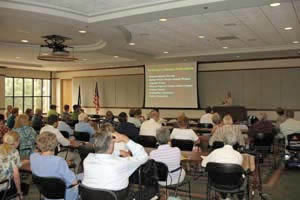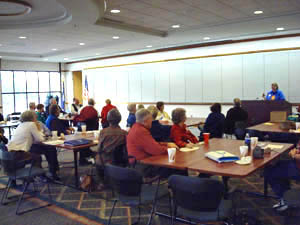|
 |
WHAT IS PARKINSON'S DISEASE?
A Brief Overview
Parkinson's disease (PD) - sometimes is called a brain disorder. PD was first described in 1817 by James Parkinson, in "An Essay on the Shaking Palsy." Parkinson’s is a progressive disorder that is caused by degeneration of nerve cells in the part of the brain called the substantia nigra, which controls movement. These nerve cells die or become impaired, losing the ability to produce an important chemical called dopamine. You cannot give it to or catch it from someone through contact. It is generally believed that the disease is a result of a combination of both genetic and environmental causes.
Society pays an enormous price for PD. The total cost to the nation is estimated to exceed $6 billion annually. The risk of PD increases with age, so analysts expect the financial and public health impact of this disease to increase as the population gets older.
|
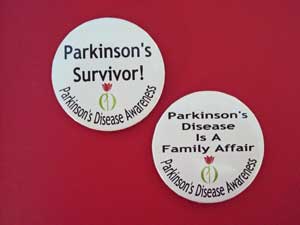 Buttons Created by Kay Perricelli
Buttons Created by Kay Perricelli
Photo by Dottie Gantt
|
What is the difference between Alzheimer’s and Parkinson’s?
Parkinson’s and Alzheimer’s have been called “kissing cousins” because they both are caused by degeneration of brain cells in different parts of the brain. Alzheimer’s causes memory loss, and Parkinson’s causes loss of the motor movement of the body. Some Parkinson’s patients can develop Alzheimer’s.
Return to top of this page
|
Learn More About Young Onset Parkinson's Disease - Order This Handbook
"If you are young and have Parkinson's disease, you and your family are likely to have numerous questions. How will Parkinson's affect you and those you care about, and how might you have an impact on it? The American Parkinson Disease Association (APDA) and our National Young Onset Center are here to provide you with the education and support you need in order to make important decisions about your health and your life."
"To answer many of your questions, were are pleased to make our Young Parkinson's Handbook available to you at no cost. Since our founding in 1961, APDA has been diligently working to "Ease the Burden -- Find a Cure" for Parkinson’s disease through research, patient and family support, and education."
The above is taken from the American Parkinson Disease Association (APDA) website at this link http://tinyurl.com/c5hzp3n where you can obtain the handbook.
Return to top of this page |
What are the physical effects of Parkinson’s?
Without enough dopamine, the brains chemical and neuro balance for the cells involved in movement is disrupted, resulting in tremor (trembling in the hands, arms, legs and jaw); rigidity (stiffness of the limbs); slowness of movement; and impaired balance and coordination – the hallmark symptoms of Parkinson's. Parkinson’s disease is a chronic condition, which means it is life long (until a cure is found). It is not infectious or contagious. Parkinson’s affects different people in different ways. For instance, most people associate shaking or “tremor” with Parkinson’s disease, but some people may not experience this symptom.
Return to top of this page
|
| Did You Know?
Every 9 minutes an individual is diagnosed with Parkinson's Disease
There is no “definitive test” that can confirm Parkinson's disease, except after death
Parkinson's is not just your "grandparent's" disease or for "old" people
The incidence of Parkinson’s increases with age, but an estimated four percent of people with PD are diagnosed before the age of 50
Currently there is "no cure" for Parkinson's
Medication can substitute for the missing dopamine, but it is only a temporary solution
There are estimated 60,000 new cases of Parkinson's Disease a year, and this number does not reflect the thousands of cases that go undetected.
There "are more than" 1,500,000 people estimated to have
Parkinson's in the United States - which is more than the combined number of people diagnosed with multiple sclerosis, muscular dystrophy and Lou Gehrig's disease
1 in 100 people will have Parkinson's disease
Men are one and a half times more likely to have Parkinson's than women
The combined direct and indirect cost of Parkinson’s, including treatment, social security payments and lost income from inability to work, is estimated to be nearly $25 billion per year in the United States alone
Without more federal funding for research to find a cure for Parkinson's,
the
numbers of Parkinson patients will only increase each year |
Return to top of this page
|
How is Parkinson’s diagnosed?
Parkinson's diagnosis is primarily based on common symptoms listed below. There is no “definitive test” (i.e., x-ray or blood test) that can confirm the disease. While very expensive, an emission tomography (PET) can support a medical diagnosis. Conventional methods for diagnosis include:
- The presence of majority of the four primary symptoms - tremor, or trembling; muscle rigidity or stiffness of the limbs; gradual loss of spontaneous movement (slowness of movement - bradykinesia); balance problems (postural instability)
- The absence of other neurological signs upon examination
- No history of other possible causes of parkinsonism, such as the use of tranquilizer medications, head trauma or stroke
- Responsiveness to Parkinson's medications, such as levodopa
Return to top of this page
|
 Photo Provided by
Photo Provided by
PBS Charlie Rose Brain Series Web site
|
What is a Movement Disorder Specialist? -and- Why do I need one?
"In the United States and Canada, neurologists are physicians who have completed postgraduate training in neurology after graduation from medical school. Neurologists complete, on average, at least 12 years of college education and clinical training. This training includes obtaining a four-year undergraduate degree, a medical degree, which is an additional four years, and then completing a three or four-year residency in neurology. The four-year residency consists of one year of internal medicine training followed by three years of training in neurology. One and two year fellowships are available following completion of the neurology residency if desired."
"Many neurologists also have additional subspecialty training (fellowships) after completing their residency in one area of neurology such as stroke or vascular neurology, interventional neurology, epilepsy, neuromuscular, neurorehabilitation, behavioral neurology, sleep medicine, pain management, neuroimmunology, clinical neurophysiology, or movement disorders."
The above definition was found on the web site at http://en.wikipedia.org/wiki/Movement_disorder_specialist
"A Movement Disorders Specialist is a neurologist who has taken additional training in the subspecialty in neurology called movement disorders (as compared to other subspecialties in neurology). This encompasses disorders such as Parkinson's disease (and the Parkinson-Plus disorders such as Shy-Drager Syndrome and Progressive Supranuclear Palsy), essential tremor, dystonia, Restless Leg Syndrome, Myoclonus and Wilson's disease. Movement Disorders Specialists are most often also involved in research and/or teaching in addition to their clinical concerns and are more typically found at major medical institutions. Such professionals typically follow a greater number of patients with these disorders so are thus generally more experienced in the use of the various medications (ad their combinations) as compared to a general neurologist, an internist or general practitioner."
The above definition was found on the web site at www.pdcaregiver.org/MovementDisorder.html
Return to top of this page
A Recommendation by the Columbia Parkinson's Support Group
Many people feel that their family doctors provide very good care right in their local neighborhood. They value the convenience of having a local doctor who is devoted 100% to clinical care; and they want to receive consistent standard care. We strongly support having local doctors treat their Parkinson patients. It is unfortunate that not all local doctors (including neurologists) are specialists in Parkinson's disease; thus sometimes a patient's symptoms can be misdiagnosed as Parkinson's.
In addition to seeing your local doctors, if you are not currently seeing a Movement Disorder Specialist or a neurologist who specializes in Parkinson's, we recommend and encourage you to consult - at least once for a second opinion - a neurologist who is a Movement Disorder Specialist in Parkinson's.
Going to a neurologist who is a Movement Disorder Specialist is very important; because these doctors are experienced, perceptive, compassionate and "on the cutting edge" of new treatments for Parkinson's. Movement Disorder Specialists are aware of all current therapies, their benefits and their side effects. These specialists can coordinate the best course of treatment for each person with the patient's local doctors. Movement Disorder Specialists (including some Geriatricians) who specialize Parkinson's are much more likely to be aware of the most current research on DBS and other options. They are also more likely to have personal contacts with neurosurgeons that perform DBS and other Parkinson related surgeries.
Return to top of this page |
What is the difference between a Neurosurgeon and a Neurologist?
"A neurologist is a physician with training and expertise in the evaluation and medical management of neurological disorders. Neurosurgeons and neurologists share many of the same patients and often work together for the optimal care of the person. Many conditions are effectively treated by either specialist with some conditions being best managed without surgery and others with operations. When medical intervention fails or is not acceptable, the neurologist will frequently request the assistance of a neurosurgeon to evaluate the potential for a surgical treatment. Many problems are structural in nature and may therefore respond best to neurosurgical intervention. It is much like the cardiologist who manages heart disease with medical intervention and the cardiac surgeon who offers surgery for those who have failed treatment with medications. Frequently, patients are sent to a neurologist by their primary care physician and, based upon the problem, subsequently referred to the Neurosurgeon for their surgical expertise."
The above definition was found on the web site at www.columbianeurosurgical.com/neuro.htm - which also has more information about neurosurgery.
Return to top of this page
|

Singer
Johnny Cash |
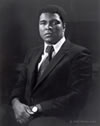
Boxer
Muhammad Ali |

President
Yasser Arafat |

Artist
Salvador Dalai |

General
Mac Arthur |
 Actor
Michael J. Fox |
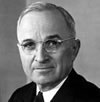
President
Harry Truman |
Return to top of this page
|
Who is affected by Parkinson’s?
Currently there is no way to predict or prevent Parkinson's disease which strikes randomly affecting all genders, races, socio-economic groups and lifestyles. An estimated 1.5 million Americans have the Parkinson's disease, while an estimated 60,000 new cases are diagnosed each year. As many as one in 15 people are diagnosed with Parkinson's before age 50. There were nearly 18,000 Parkinson’s disease-related deaths in the United States in 2003.
Parkinson's disease is on the increase all over the world, and is now affecting younger people (as young as 30 years of age). Parkinson's is not just your grandparent's disease. There has been an alarming increase in the rate of diagnosis among young people. While the condition usually develops after the age of 55, the disease may affect people in their 30s and 40s, such as actor Michael J. Fox, diagnosed at age 30. Slightly more men are diagnosed with PD than women - for every 3 men there are 2 women with the disease.
Parkinson's symptoms manifest differently in different patients; where patients experience some symptoms and not others, and even the pace at which the disease worsens varies on an individual basis.
Return to top of this page
|

Actress
Katherine Hepburn |

Evangelist
Billy Graham |

Actress
Deborah Karr |

Fuehrer
Adolf Hitler |

Attorney General
Janet Reno |

Actor
Vincent Price |
 Pope
Pope
John Paul II |
|
Return to top of this page
Is there a cure for Parkinson’s?
Parkinson’s presently has no cure, but new medications and surgical treatments are being developed and made available to help manage some of the debilitating symptoms.
|
How is Parkinson’s treated?
The majority of Parkinson's patients are treated with medications to relieve the symptoms of the disease. As Parkinson’s progresses, some patients develop major fluctuations in their response to treatment, known as "motor fluctuations. Should there be a deterioration of a patient's quality of life, and a patient’s overall health, surgery may be the next step.
Deep brain stimulation (DBS) has increasingly become the surgical method of choice where it is available, other older surgeries such as pallidotomies and thalatomies are used less often than they used to be. DBS is where the surgeon implants small electrodes which are implanted in the deep parts of the brain involved with motor function to provide a consistent electrical impulse.
Experimental research includes stem cell research, which is a promising field that has created political and ethical controversy. The controversial cell replacement therapy is designed to replace the neurons that degenerate in PD. There are a variety of potential sources of cells (embryonic stem cells versus adult stem cells) for this therapy. A stem cell has the potential to differentiate into any cell type in the body. The premise of this approach is that stem cells in a dish can be coaxed to become healthy dopamine neurons, which can then be transplanted into the brain to replace the sick and dying neurons in Parkinson's disease.
Medical research continues to investigate the causes to find a possible cure, and to develop improved treatment options to help enhance the quality of life for Parkinson’s patients. There is every hope that continuous medical research advancements will yield further understanding of this disease, better therapies, and ultimately a cure and prevention.
Return to top of this page
|
Return to top of this page
|
|

